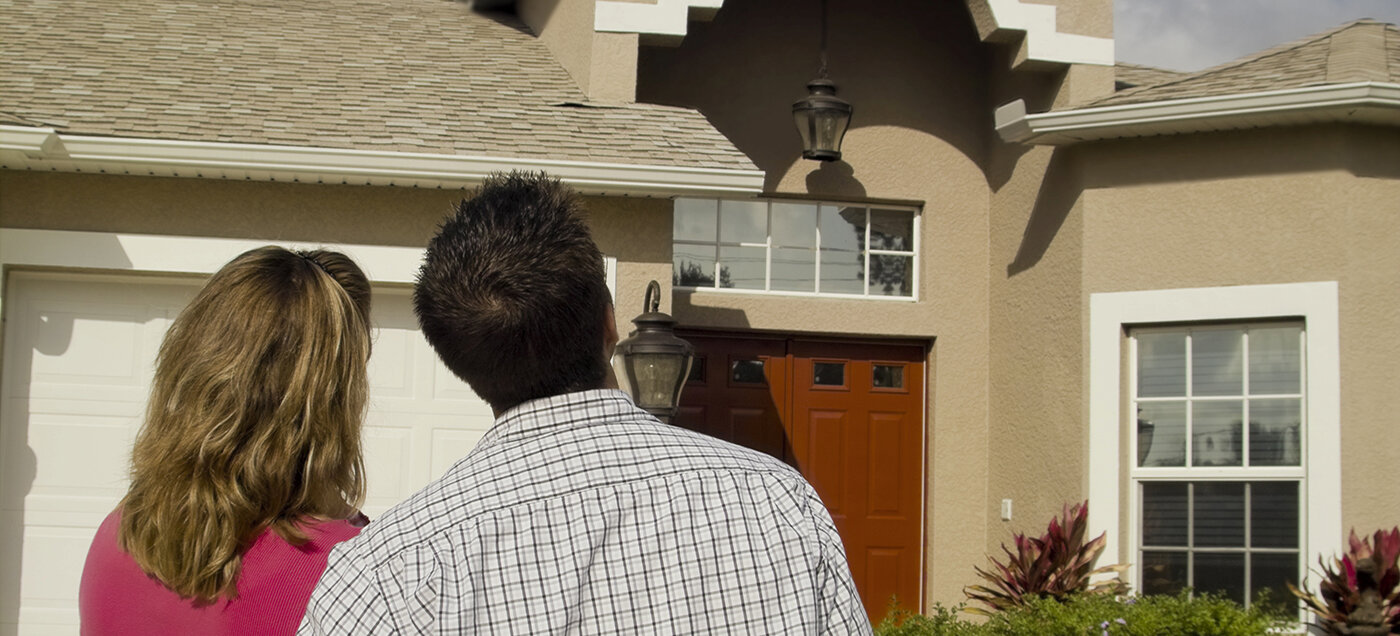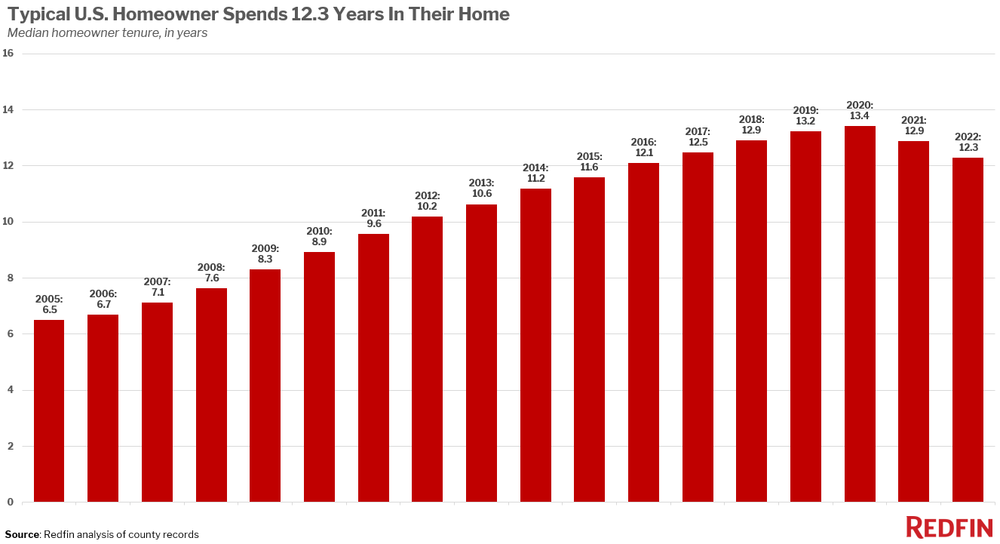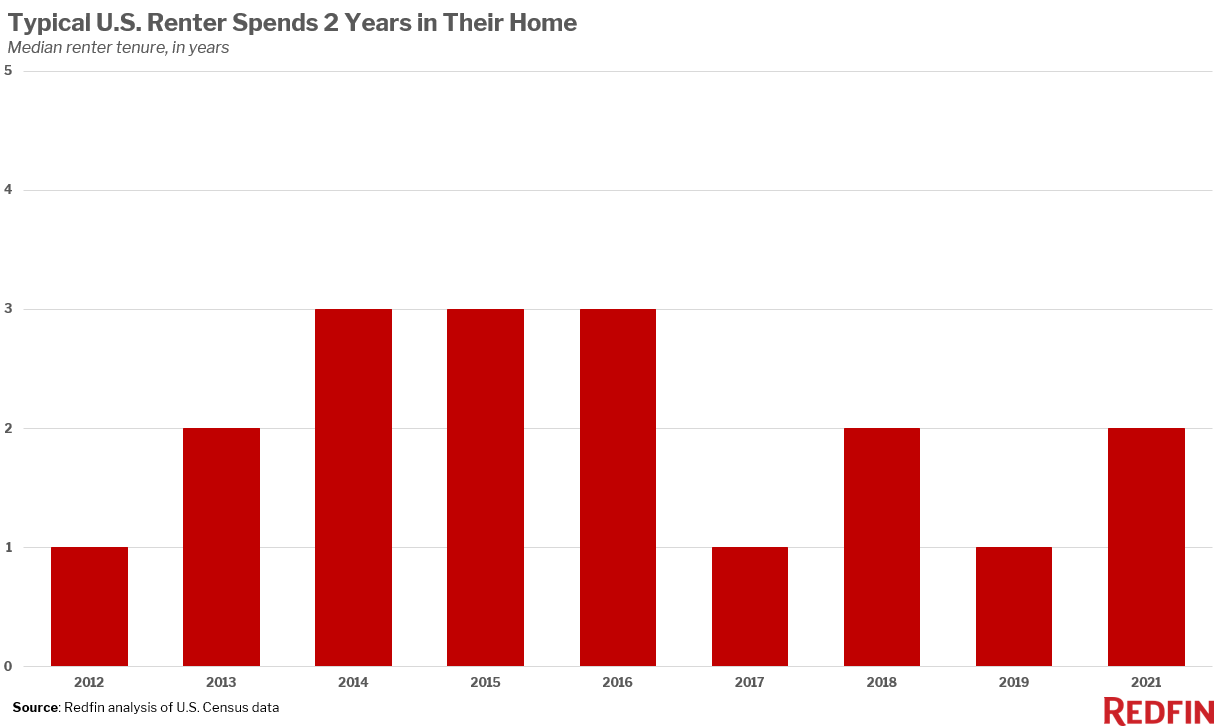Residential Real Estate News

Homes Change Hands Every 12 Years in America
Residential News » Seattle Edition | By David Barley | March 2, 2023 8:48 AM ET
Down From 2020 Peak of 13.4 Years of Ownership Tenure
National property broker Redfin is reporting this week the typical U.S. homeowner spends 12.3 years in their homes now. That's down from the peak of 13.4 years hit in 2020 and 12.9 years in 2021.
But the typical American is still living in their home much longer than before, with median homeowner tenure sitting at about 10 years in 2012 and 6.5 years in 2005.
Older people aging in place are driving the general trend toward longer homeowner tenure. Most Americans 65 and older have owned their home for at least 23 years, and most Americans aged 35 to 64 have owned theirs for at least eight years. Compare that with homeowners under 35: Nearly half (49%) have owned their home for three years or less, and another 37% have owned theirs for four to seven years.
Overall homeowner tenure has ticked down from its peak largely because so many people moved from one home to another in 2021 and the first half of 2022. Record-low mortgage rates during that period motivated many Americans to buy homes, either becoming homeowners for the first time or selling their home to move to a better one. Pandemic-fueled remote work prompted many Americans to relocate to a different part of the country, too.
But Americans are staying put much longer now than in the past couple decades. There are several reasons why that's true, and why homeowner tenure is likely to stay elevated in the coming decade:
- Older Americans are aging in place. Long homeowner tenure is driven by older generations and the population is aging. Roughly 17% of people in the U.S. are 65 or older, up from about 13% in 2010, and the share is expected to continue increasing.
- Lack of affordability. Typical monthly mortgage payments are near their record high, discouraging many people from moving.
- Lack of move-up buyers. Roughly 85% of mortgage holders have an interest rate far below 6%, disincentivizing them from giving up their comparatively low rate and moving.
- Historically high rental prices. Asking rents are still higher than they were before the pandemic. That's motivating some homeowners to become landlords rather than sell.
- Shortage of homes for sale. The supply of homes for sale is near historic lows and very few new listings are coming on the market. Even if a homeowner were considering a move, there's not much to choose from.
"Even though the length of time Americans are staying in their homes has ticked down from the peak it reached in 2020, it's likely to head back up again in the next few years," said Redfin Senior Economist Sheharyar Bokhari. "Today's mortgage rates are more than double the lows reached during the pandemic homebuying frenzy, which means people have extra incentive to hang onto their homes. Even if rates dip down to 4% or 5%, that's still significantly higher than the sub-3% rates many homeowners have now. That lock-in effect, combined with older Americans' desire to stay put in their homes, points to lengthening tenure in the future."
"But although that limits the number of homes hitting the market, competing forces could help the supply shortage," Bokhari continued. "Remote work is still much more popular than before the pandemic, so more people have the freedom to relocate or move further away from city centers. Plus, millennials--the largest generation in the U.S.--are in prime moving years, pushed to sell their homes by things like growing families and new jobs."
Renters move much more often than homeowners, which creates a mismatch between the number of homes for sale and the people who want to buy one
The scarcity of homes for sale is contributing to double-digit homeowner tenure, and the reverse is also true: Long tenure is holding back supply.
That's problematic for people who want to buy a home but are unable to find one they can afford. The fact that renters move much more often illustrates the issue. The typical renter stayed in their home for two years in 2021, versus 13 years for homeowners. Most renters have to move to another rental rather than buy a home because of the mismatch between the number of people moving and the number of homeowners listing their home during any given year.
That's especially true for younger Americans because they move more often. Nearly three-quarters (72%) of renters under 35 years old spend three years or less in a rental property, compared with 39% of 35-64 year olds and 27% of people aged 65 and older.
Overall, the typical length of time renters stay in any one rental home hasn't fluctuated much over the last decade. The median has bounced between one, two and three years for the last decade.
Californians keep their homes longest; homeowners in Louisville and Las Vegas hold on less than half as long before moving
Homeowners stay put longest in expensive parts of California. The typical Los Angeles homeowner has owned their home for 18.2 years, followed by 17.3 years in San Jose. Cleveland (17.1 years), San Francisco (16.3 years) and Memphis (16.2 years) round out the top five.
Tenure is shortest in relatively affordable migration destinations in the southern half of the country. It's shortest in Louisville, KY (6.9 years), followed by Las Vegas (7.6 years), Nashville (8.2 years), Raleigh (8.3 years) and Charlotte (8.3 years).
Sign Up Free | The WPJ Weekly Newsletter
Relevant real estate news.
Actionable market intelligence.
Right to your inbox every week.
Real Estate Listings Showcase
Related News Stories
Residential Real Estate Headlines
- U.S. New-Home Sales Surge in August as Mortgage Rates Ease
- Despite Increased Foreign Buyer Activity, Miami Residential Sales Dip 11 Percent in August
- California Home Sales Enjoy Modest Uptick as Mortgage Rates Ease
- U.S. Home-Flipping Profits Sink to Lowest Level Since 2008 Financial Crisis as Costs Climb
- Why the World's Rich Are Flocking to Europe in 2025
- Federal Reserve Delivers First Rate Cut of 2025 as Mortgage Relief Proves Limited
- Homebuilder Sentiment Holds Steady in U.S. as Rate-Cut Bets Lift Outlook
- U.S. Mortgage Rates Experience Sharpest Weekly Drop in Over a Year
- U.S. Foreclosures Rise for Sixth Straight Month as Affordability Pressures Mount
- Black U.S. Homeownership Rate Falls to Two-Year Low as Job Losses Mount
- Las Vegas Home Prices Flatten as Listings Surge, Sales Slow
- Cooling Miami Housing Market Sees 16 Percent Annual Sales Drop in July
- U.S. Mortgage Delinquencies Uptick in June Amid Regional Pressures
- California, Florida Top U.S. Housing Markets Most at Risk of Downturn
- 30-Year Mortgage Drops to 6.56 Percent in Late August, Lowest Since October 2024
- Investors Maintain Elevated Role in U.S. Housing Market Despite Slight Pullback
- Pending Home Sales Show Mixed Signals as U.S. Buyers Remain Cautious
- Canadian Home Sales Extend Recovery in July
- U.S. Home Sales Rise in July as Buyers Gain More Bargaining Power
- Zombie Foreclosures Edge Up Across U.S.
- 2.6 Million Homes at Wildfire Risk Across 14 Western States in 2025
- One in Five Americans Willing to Trade Personal Safety for Home Affordability
- U.S. Home Price Growth Slows as Affordability Pressures Mount in 2025
- U.S. Mortgage Rates Dip to Four Month Low in Early August
- U.S. Mortgage Applications Rise in Late July, Breaking Four-Week Slump
- Hong Kong's Housing Market Stuck in Stalemate as Bulls and Bears Face Off
- U.S. Condo Market Struggles in 2025
- U.S. Pending Home Sales Remain Sluggish in June
- Los Angeles Area Wildfires Destroyed Nearly $52 Billion in Homes Last January
- Greater Palm Beach Area Residential Sales Slip in June Amid Growing Inventory
- Economic Resilience Lifts U.S. Housing Outlook Going Forward
- New Home Sales Stagnate as Affordability Struggles Continue in America
- U.S. Housing Market Slips in June as Prices Hit New Highs
- Florida, California Continue to Reign Supreme as America's Ultraluxury Housing Markets
- Caribbean Housing Market Evolves into Global Second-Home Hotspot
- U.S. Home Sales See Highest June Cancellation Rate on Record
- Orlando Housing Market Cools in June as Listings Slide, Sales Slow
- Private Credit Surges in 2025 as Real Estate Developers Bypass Banks
- U.S. Condo Market Suffers Sharpest Price Drops in Over a Decade as Buyers Retreat
- Rising Taxes, Insurance Costs Undermine the Stability of U.S. Homeownership









